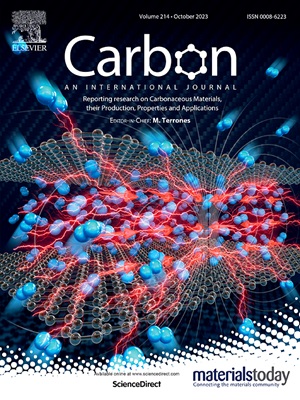Regulating heterogeneous charge distribution/magnetic resonance via ligand constraints for enhanced electromagnetic wave absorption
IF 10.5
2区 材料科学
Q1 CHEMISTRY, PHYSICAL
引用次数: 0
Abstract
With the rapid development of radar detection systems, the issue of electromagnetic wave stealth has become increasingly prominent. This paper presents a fabrication strategy for a composite material composed of CoFe2O4 quantum dots in situ loaded onto CNTs through a multi-ligand combined thermal carbon shock, aiming to optimize multiple loss mechanisms for efficient electromagnetic wave absorption. The CoFe2O4 quantum dots serve as loss centers, enhancing the heterogeneous charge distribution and the synergistic effects of magnetic resonance and magnetic exchange due to their supercritical size. Concurrently, the CNTs construct an efficient conductive network, providing a pathway for the free electrons within the CoFe2O4 crystals and enhancing conductive loss. The composite achieves an effective bandwidth of 8.02 GHz and a maximum absorption of −52.7 dB at a filling ratio of only 25 %, nearly covering the X and Ku bands. Furthermore, computer simulation techniques indicate that this coating exhibits excellent radar stealth performance on the F-22 Raptor fighter jet, presenting potential for the development and application of a new type of lightweight stealth coating.

求助全文
约1分钟内获得全文
求助全文
来源期刊

Carbon
工程技术-材料科学:综合
CiteScore
20.80
自引率
7.30%
发文量
0
审稿时长
23 days
期刊介绍:
The journal Carbon is an international multidisciplinary forum for communicating scientific advances in the field of carbon materials. It reports new findings related to the formation, structure, properties, behaviors, and technological applications of carbons. Carbons are a broad class of ordered or disordered solid phases composed primarily of elemental carbon, including but not limited to carbon black, carbon fibers and filaments, carbon nanotubes, diamond and diamond-like carbon, fullerenes, glassy carbon, graphite, graphene, graphene-oxide, porous carbons, pyrolytic carbon, and other sp2 and non-sp2 hybridized carbon systems. Carbon is the companion title to the open access journal Carbon Trends. Relevant application areas for carbon materials include biology and medicine, catalysis, electronic, optoelectronic, spintronic, high-frequency, and photonic devices, energy storage and conversion systems, environmental applications and water treatment, smart materials and systems, and structural and thermal applications.
 求助内容:
求助内容: 应助结果提醒方式:
应助结果提醒方式:


